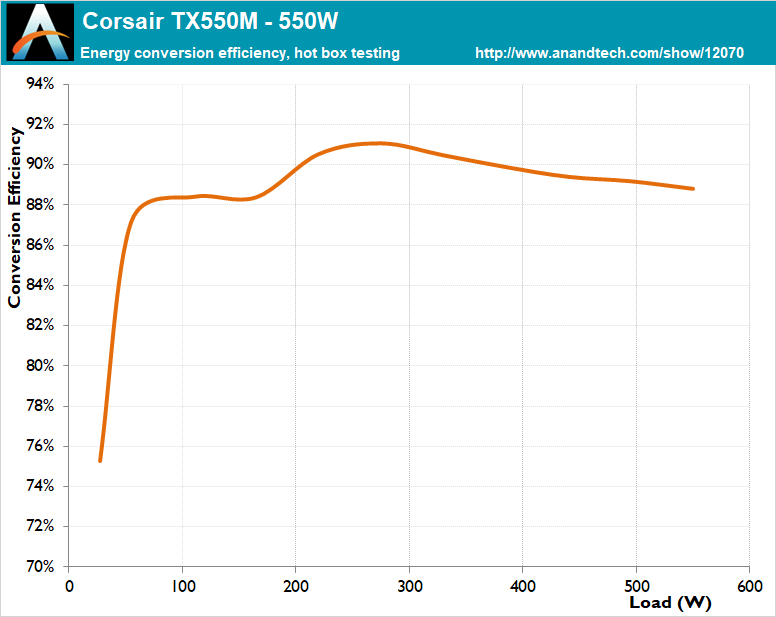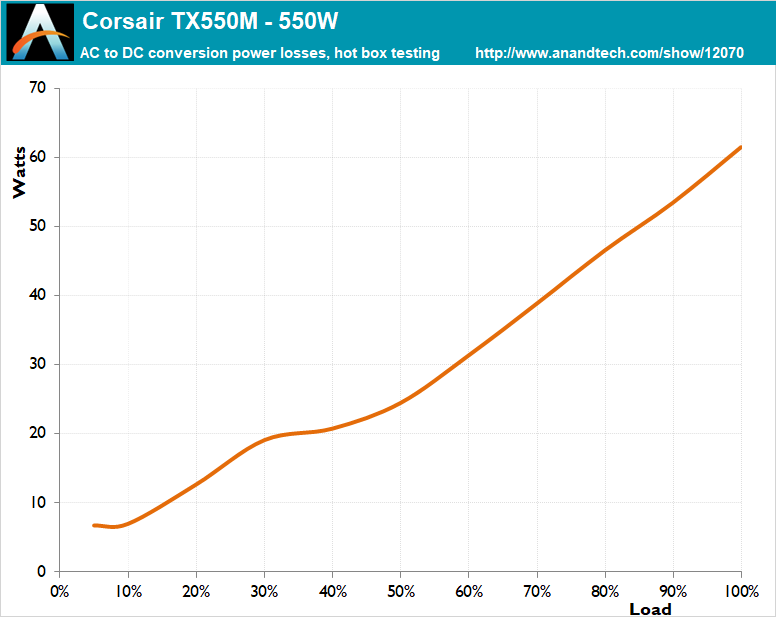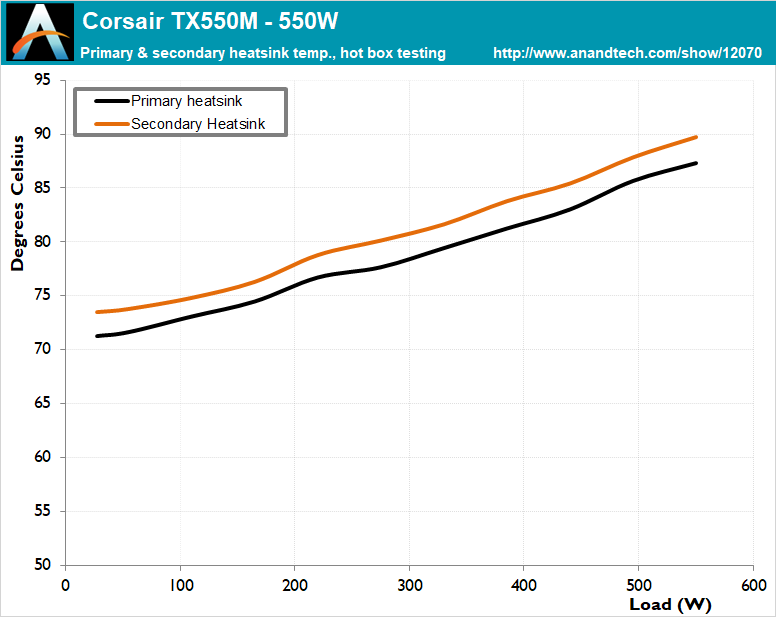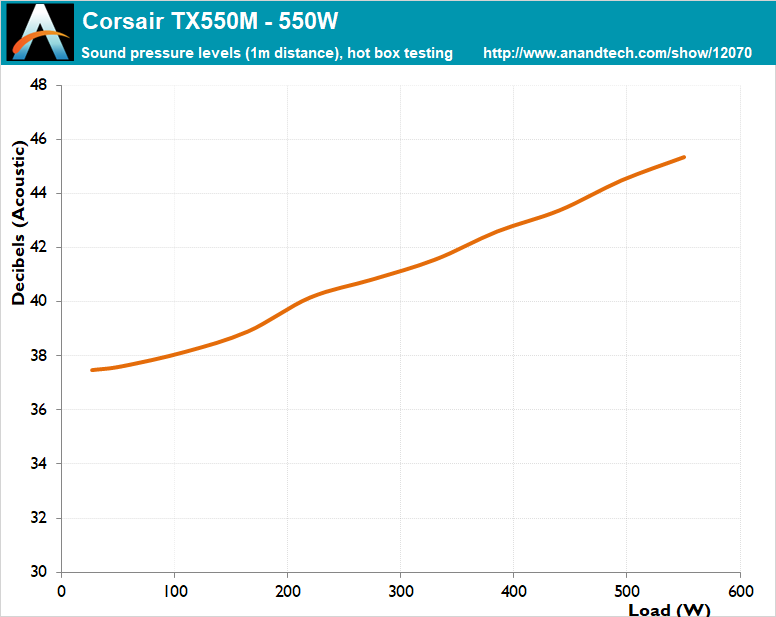The $80 Power Supply for Almost Everyone: The Corsair TX550M 80Plus Gold PSU Review
by E. Fylladitakis on December 1, 2017 8:00 AM EST- Posted in
- Cases/Cooling/PSUs
- Corsair
- PSUs
- 550W
- TX
- Modular
- Power Supply
Hot Test Results
We can see in the following tables that the electrical performance of the Corsair TX550M is very good for a mid-range PSU. Corsair definitely improved Great Wall’s designs vastly since our last encounter with them, increasing the efficiency and power quality of the platform. Although it does not impress, the maximum ripple of 36 mV on the 12V line under maximum load is a good power quality figure and satisfactory considering the price range of the PSU.
| Main Output | ||||||||
| Load (Watts) | 111.24 W | 277.4 W | 413.29 W | 549.67 W | ||||
| Load (Percent) | 20.22% | 50.44% | 75.14% | 99.94% | ||||
| Amperes | Volts | Amperes | Volts | Amperes | Volts | Amperes | Volts | |
| 3.3 V | 2.26 | 3.34 | 5.66 | 3.33 | 8.49 | 3.31 | 11.32 | 3.3 |
| 5 V | 1.81 | 5.08 | 4.53 | 5.07 | 6.79 | 5.02 | 9.06 | 5 |
| 12 V | 7.79 | 12.13 | 19.47 | 12.1 | 29.21 | 12.02 | 38.95 | 11.99 |
The TX550M appears to be a little sensitive to heavy cross-loading, with the maximum ripple on the 12V line jumping to 52 mV, but that still is a good performance figure under a highly unlikely usage scenario. The voltage regulation on every voltage line is between 1.2% and 1.4%, which is very good by today’s standards.
| Line | Regulation (20% to 100% load) |
Voltage Ripple (mV) | |||||
| 20% Load | 50% Load | 75% Load | 100% Load | CL1 12V |
CL2 3.3V + 5V |
||
| 3.3V | 1.4% | 16 | 16 | 18 | 22 | 16 | 20 |
| 5V | 1.5% | 20 | 20 | 22 | 24 | 18 | 24 |
| 12V | 1.2% | 22 | 26 | 30 | 36 | 52 | 34 |
High ambient temperatures have a measurable, but not excessive or unexpected, impact on the electrical performance of the Corsair TX550M.
The average nominal load range (20%-100%) efficiency drops by 0.7%, down to an average of 89.6%, when in a warm environment. This drop is evenly distributed across the load range, suggesting that there are no component quality or thermal stress issues. Note that the TX550M still is significantly more efficient when handling loads greater than 250 Watts.
The thermal control of the Corsair TX550M is simplistic, setting the speed of the fan mainly according to the internal temperature of the unit. Inside our hotbox, the high internal temperatures of the PSU force the fan to almost instantly reach an audible, yet typically comfortable noise level. From that point onwards, the speed of the fan is increasing almost linearly along with the load but, surprisingly, it does not ever reach painfully high noise levels. It will surely be loud at maximum load under such conditions, but we usually expect much higher noise levels from PSUs around this price range. Considering the very high ambient temperature, the internal temperature of the TX550M is good, although there definitely is room for improvement.















42 Comments
View All Comments
t.s - Saturday, December 2, 2017 - link
I mean, all the peripheral on your example is not something that will make the system spent, like 150W1_rick - Friday, December 1, 2017 - link
Well, that makes something like this model overkill for a lot of people, then. Just as an example, I have a Corsair CX-430 PSU, an overclocked Ryzen 1600X, and a GTX 950. During a GPU stress test, it will pull a bit under 250 watts. CPU stress tests are somewhat lower--I think under 200W. It idles well under 100, and normal usage is probably 120-160W.mjeffer - Friday, December 1, 2017 - link
This is one of my annoyances whenever building a new system. It's really hard to find a high quality, low wattage PSU that would represent your true needs. Most major vendors only go budget on low wattage or it's impossible to find someone who's done a teardown to see if it is made with quality parts because reviews are usually only done on grossly overpowered PSUsKAlmquist - Saturday, December 2, 2017 - link
I've been happy with the Seasonic SSR-360GP, but sadly it appears to have been discontinued. I guess the Antec EarthWatts EA-380 is worth a look.Manabu - Monday, December 18, 2017 - link
It is getting harder and harder to find high quality low wattage PSUs with enough cables. I'm using 6 sata and 3 ide and 1 6-pin vga cable (gtx 650 ti). My overclocked system draws up to 250W (measured at the wall) with linpack AVX2 and Furmark, but more normal high load is like 150-175W. Thus I would want a 350W psu for a good margin and efficiency.Instead I had to buy a 450W 80+gold psu (electricity here is expensive and it runs 24h/d). Previously I used a 420W 80+ bronze psu for 6 years and before that a 400W 80+ psu for 5 years. Power ratings are creeping up, but at least efficiency too. Still, if power ratings continue to go up efficiency for my loads will go down.
jhapp - Friday, December 1, 2017 - link
People need reliability, not 3D graphics. I always buy PNY/Quadro high resolution 2D cards which run about 10 watts per monitor. 3D video cards are expensive and energy wasting. Add them to the long list of things people don't need but think they do because of media hype, like hi-res tvs, or hybrid cars, ethanol, E85, smart phones, cell phones, ...Jimios - Friday, December 1, 2017 - link
I'd like to see you play a modern game with a 10W 2D Quadro.MadAd - Friday, December 1, 2017 - link
With CPUs providing basic graphics these days I dont think the average user would buy a 3d card unless they actually had an app demanding it, eg for me Planetside 2 wouldnt even work without a serious graphics card, otherwise I wouldnt bother and just use the onboard.Dr. Swag - Friday, December 1, 2017 - link
But if you want to play video games...LukaP - Friday, December 1, 2017 - link
Even if you dont, iGPUs exist, on both sides...